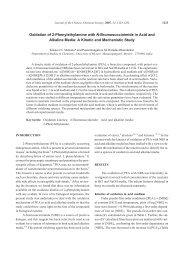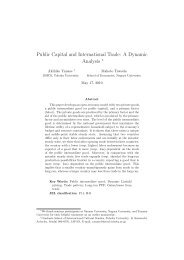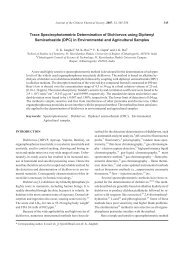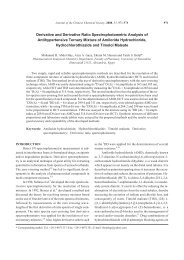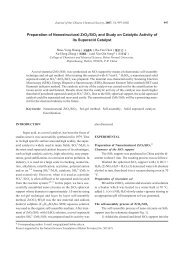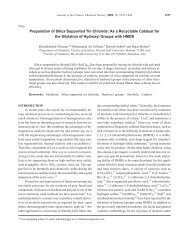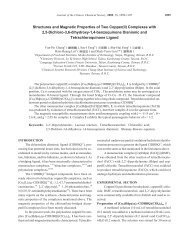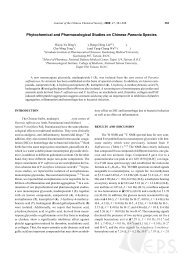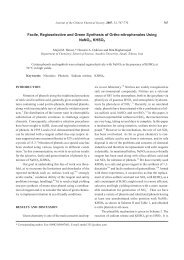Biotinylation of Peptides/Proteins using Biocytin Hydrazide
Biotinylation of Peptides/Proteins using Biocytin Hydrazide
Biotinylation of Peptides/Proteins using Biocytin Hydrazide
Create successful ePaper yourself
Turn your PDF publications into a flip-book with our unique Google optimized e-Paper software.
<strong>Biotinylation</strong> <strong>of</strong> <strong>Peptides</strong>/<strong>Proteins</strong> <strong>using</strong> <strong>Biocytin</strong> <strong>Hydrazide</strong> J. Chin. Chem. Soc., Vol. 54, No. 2, 2007 545<br />
It is noted that the cross-linking ion between two insulins<br />
and one adipic dihydrazide was detected at m/z 11609 (data<br />
not shown). Results indicate that it is the hydrazide functional<br />
group <strong>of</strong> the biotinylated reagents that is responsible<br />
for the biotinylation reaction. Compared to the traditional<br />
biotinylation reagents such as N-hydroxysuccinimide (NHS)biotin<br />
(NH2 reactive), maleimides-biotin (SH reactive),<br />
and carbodiimides-biotin (COOH reactive), biocytin hydrazide<br />
only requires a simple one-step chemical reaction<br />
without a solubility problem to biotinylated peptides/proteins.<br />
Fig. 4 shows the time course <strong>of</strong> biotinylating insulin<br />
and lysozyme <strong>using</strong> 1 M biocytin hydrazide in 10% (v/v)<br />
Fig. 2. The MALDI-TOF spectra <strong>of</strong> intact and biotinylated<br />
proteins (cytochrome c, lysozyme, trypsin<br />
inhibitor, and BSA): (I a) Cytochrome c at<br />
37 C for 96 h in 10% TFA (v/v) aqueous solution<br />
without biocytin hydrazide; (I b) Cytochrome<br />
c at 37 C for 96 h in 10% TFA (v/v)<br />
aqueous solution with 0.3 M biocytin hydrazide;<br />
(II a) Lysozyme at 65 C for 24 h in 10%<br />
TFA (v/v) aqueous solution without biocytin<br />
hydrazide; (II b) Lysozyme at 65 C for 24 h in<br />
10% TFA (v/v) aqueous solution with 1 M<br />
biocytin hydrazide; (III a) Trypsin inhibitor at<br />
65 C for 19 h in PBS without biocytin hydrazide;<br />
(III b) Trypsin inhibitor at 65 C for 19 h<br />
in PBS with 1 M biocytin hydrazide; (IV a) BSA<br />
at 65 C for 19 h in PBS without biocytin hydrazide;<br />
(IV b) BSA at 65 C for 19 h in PBS with 1<br />
M biocytin hydrazide. Protein solution (1<br />
g/l) was processed with Zip-Tip packed with<br />
C4 resin before MALDI-TOF MS. Sinapinic<br />
acid was used as the matrix. Contaminant is<br />
marked by an asterisk.<br />
TFA at 65 C. Within 4 h <strong>of</strong> incubation, up to two biocytin<br />
hydrazide molecules are attached to both insulin and lysozyme.<br />
With longer incubation time, more biocytin hydrazide<br />
molecules attach to both insulin and lysozyme. After<br />
24 h <strong>of</strong> incubation, up to 6 biocytin hydrazide molecules attach<br />
to both insulin and lysozyme. This data indicates that<br />
Fig. 3. The MALDI-TOF spectra <strong>of</strong> the reaction <strong>of</strong> insulin<br />
with 0.3 M <strong>of</strong> biocytin HCl, phenyl hydrazine,<br />
adipic dihydrazide, 2-iminobiotin, or 2iminobiotin<br />
hydrazide at 65 C and 5.5 h. Aqueous<br />
solution <strong>of</strong> 50% acetonitrile (v/v) containing<br />
1% TFA (v/v) was used as the solvent. Peptide<br />
solution (1 g/l) was processed with Zip-<br />
Tip packed with C18 resin before MALDI-TOF<br />
MS. CHCA was used as the matrix.<br />
Fig. 4. Time courses <strong>of</strong> the biotinylation <strong>of</strong> insulin and<br />
lysozyme at 65 C with 1 M biocytin hydrazide<br />
in 10% TFA (v/v) aqueous solution by MALDI-<br />
TOF MS. Peptide/protein solution (1 g/l)<br />
was processed with Zip-Tip before MALDI-<br />
TOF MS.



